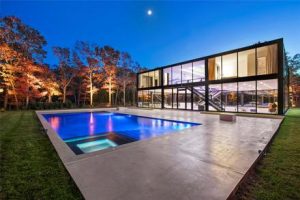Who wants to live in a glass house?
When you say “The Hamptons” and “real estate” in the same sentence, you’re bound to generate a lot of interest. One interesting property that’s currently on the market is a $5.5 million, 10,000-sq. ft, 6-bedroom, 6-bathroom home with a custom Scavolini kitchen, Gaggenau appliances, radiant floor heating, air conditioning, skylights, a heated pool and a garage. It also has floor to ceiling windows throughout. Yes, it’s all-glass.
If you’re worried about nosy neighbors, we note that the home is situated on nearly 2 acres and surrounded by trees. Lots of trees. And a 20-acre preserve.
The home was designed by Juan Figueroa and engineered by Jeff Smilow, who also engineered NYC’s Freedom Tower. The two-story home features two independent staircases that lead either to one of two master suites or four guest bedrooms. A quick trip through a basement tunnel will get you out to the home’s four-car detached garage.
The glass home design isn’t new. The late architect Phillip Johnson popularized the post-modern “glass house” design with his iconic Glass House, which he built in 1949 and where he resided until his death in 2005 at the age of 98. Built in New Canaan, CT, the structure, along with three companion buildings are now a National Trust for Historic Preservation site. Johnson was heavily influenced by German architect Ludwig Mies van der Rohe, one of the fathers of modern architecture.
While the house in the Hamptons is a Johnson-style all-glass abode, most “glass house” designs feature glass on one or two sides that often face a scenic view. Heavy use of glass is becoming a thing for homes on both coasts that are lucky enough to have an ocean view. Architectural elements like glass staircases that appear to float from floor to floor are also a welcome addition.
If an all-glass home isn’t in your budget, you can still make excellent use of glass in decorating your own home, often with a little help from Glassprimer™ glass paint.
Glassprimer™ glass paint is a specialized glass coating that bonds permanently to glass surfaces. GlassPrimer also makes a glass surface molecular activator that is designed to work with UV-inkjet glass printing processes. For more information about Glassprimer™ glass paint, please visit the rest of our site. If you’d like to purchase Glassprimer™ glass paint, please visit our online store .
Photo Credit: Douglas Elliman Real Estate

